Graduate Nursing Application: Clinical Reasoning & Program Analysis
VerifiedAdded on 2023/06/15
|11
|3519
|364
Report
AI Summary
This report provides an overview of clinical reasoning in nursing, focusing on its application within a graduate program context. It includes self-reflection on personal attributes relevant to a chosen nursing program, an analysis of immediate actions required when encountering a patient experiencing a seizure, and a discussion on prioritizing patient needs in complex scenarios. The report also addresses the importance of professional ethics in nursing practice, particularly concerning patient respect and safety. The overall aim is to demonstrate the integration of clinical reasoning, ethical considerations, and practical skills essential for effective nursing practice, highlighting the critical role of nurses in ensuring patient well-being and safety.
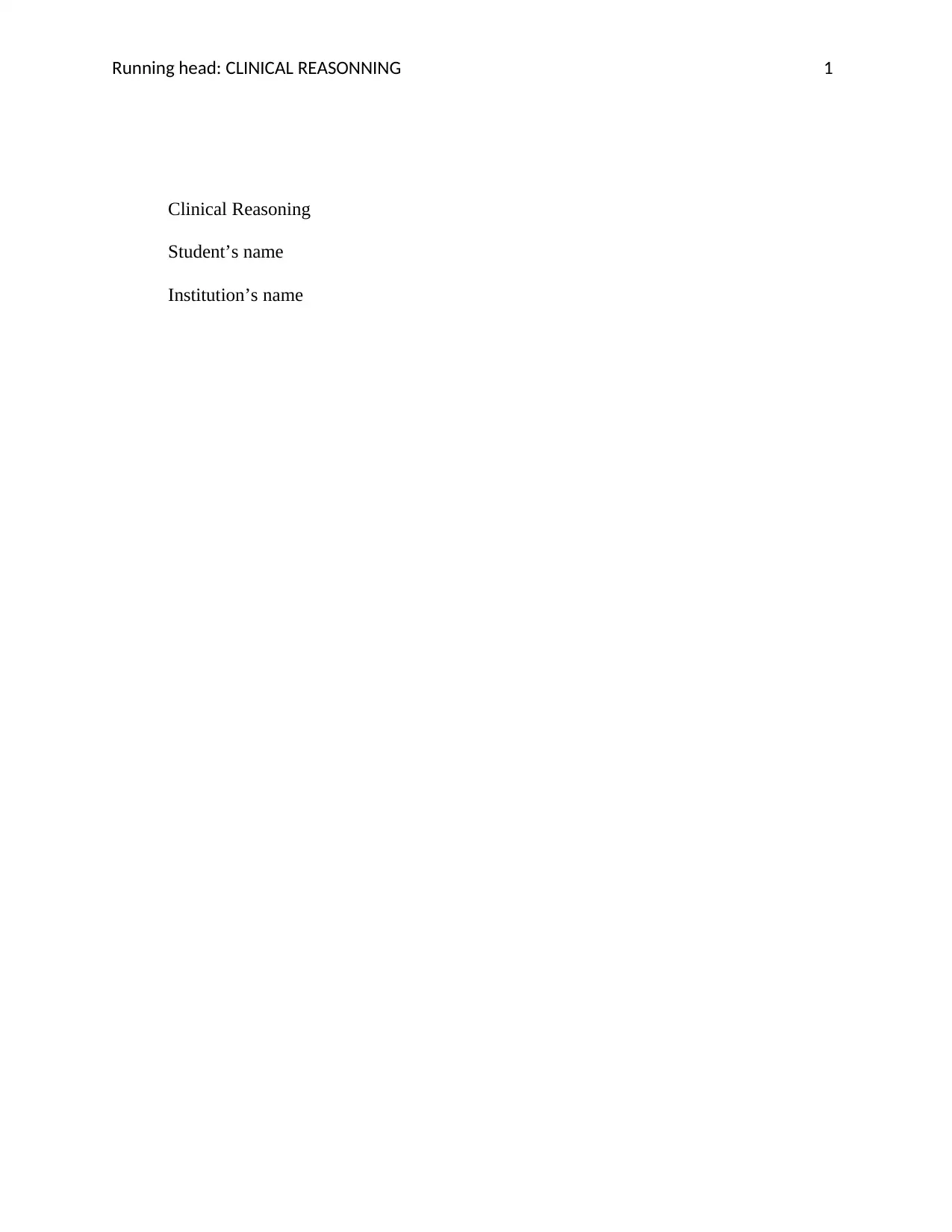
Running head: CLINICAL REASONNING 1
Clinical Reasoning
Student’s name
Institution’s name
Clinical Reasoning
Student’s name
Institution’s name
Paraphrase This Document
Need a fresh take? Get an instant paraphrase of this document with our AI Paraphraser
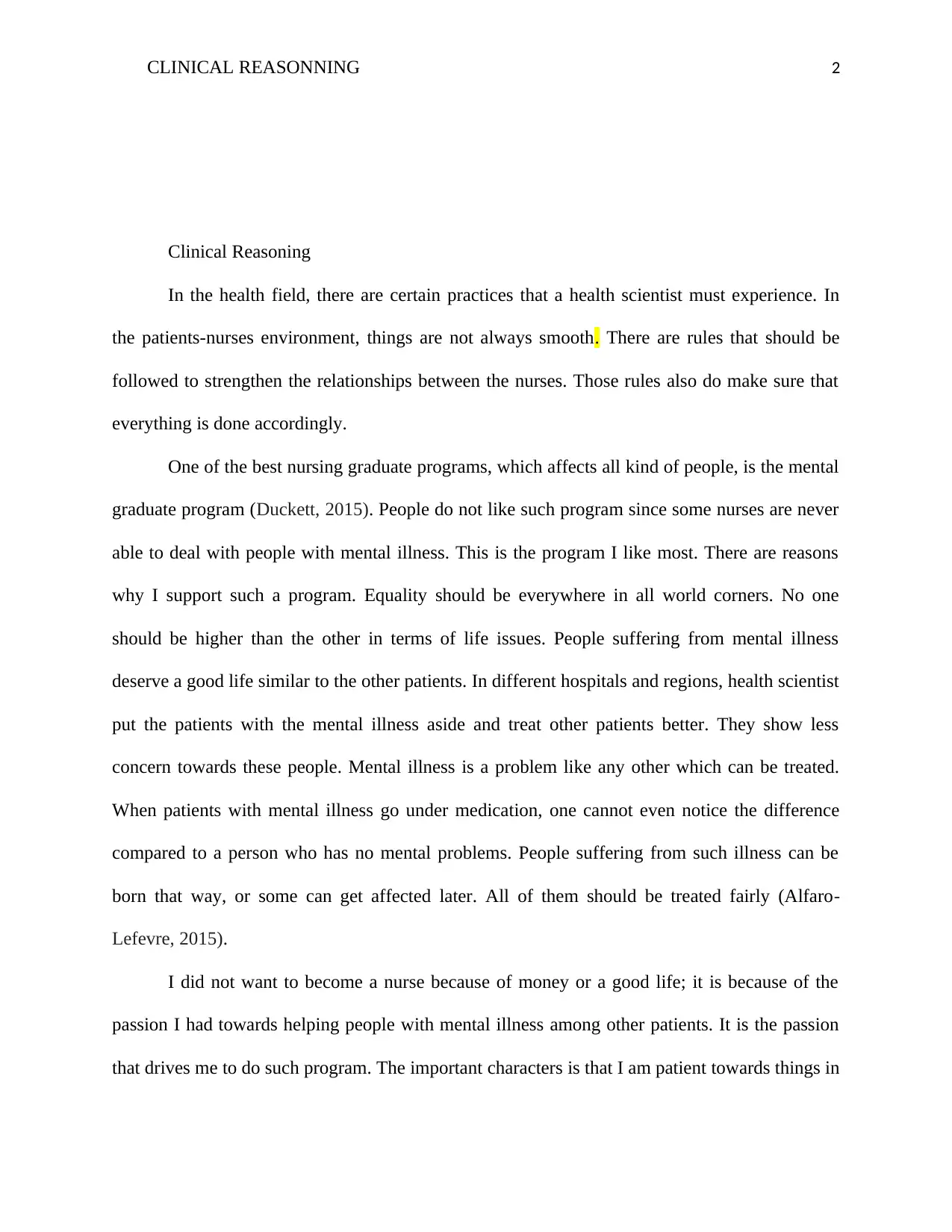
CLINICAL REASONNING 2
Clinical Reasoning
In the health field, there are certain practices that a health scientist must experience. In
the patients-nurses environment, things are not always smooth. There are rules that should be
followed to strengthen the relationships between the nurses. Those rules also do make sure that
everything is done accordingly.
One of the best nursing graduate programs, which affects all kind of people, is the mental
graduate program (Duckett, 2015). People do not like such program since some nurses are never
able to deal with people with mental illness. This is the program I like most. There are reasons
why I support such a program. Equality should be everywhere in all world corners. No one
should be higher than the other in terms of life issues. People suffering from mental illness
deserve a good life similar to the other patients. In different hospitals and regions, health scientist
put the patients with the mental illness aside and treat other patients better. They show less
concern towards these people. Mental illness is a problem like any other which can be treated.
When patients with mental illness go under medication, one cannot even notice the difference
compared to a person who has no mental problems. People suffering from such illness can be
born that way, or some can get affected later. All of them should be treated fairly (Alfaro-
Lefevre, 2015).
I did not want to become a nurse because of money or a good life; it is because of the
passion I had towards helping people with mental illness among other patients. It is the passion
that drives me to do such program. The important characters is that I am patient towards things in
Clinical Reasoning
In the health field, there are certain practices that a health scientist must experience. In
the patients-nurses environment, things are not always smooth. There are rules that should be
followed to strengthen the relationships between the nurses. Those rules also do make sure that
everything is done accordingly.
One of the best nursing graduate programs, which affects all kind of people, is the mental
graduate program (Duckett, 2015). People do not like such program since some nurses are never
able to deal with people with mental illness. This is the program I like most. There are reasons
why I support such a program. Equality should be everywhere in all world corners. No one
should be higher than the other in terms of life issues. People suffering from mental illness
deserve a good life similar to the other patients. In different hospitals and regions, health scientist
put the patients with the mental illness aside and treat other patients better. They show less
concern towards these people. Mental illness is a problem like any other which can be treated.
When patients with mental illness go under medication, one cannot even notice the difference
compared to a person who has no mental problems. People suffering from such illness can be
born that way, or some can get affected later. All of them should be treated fairly (Alfaro-
Lefevre, 2015).
I did not want to become a nurse because of money or a good life; it is because of the
passion I had towards helping people with mental illness among other patients. It is the passion
that drives me to do such program. The important characters is that I am patient towards things in
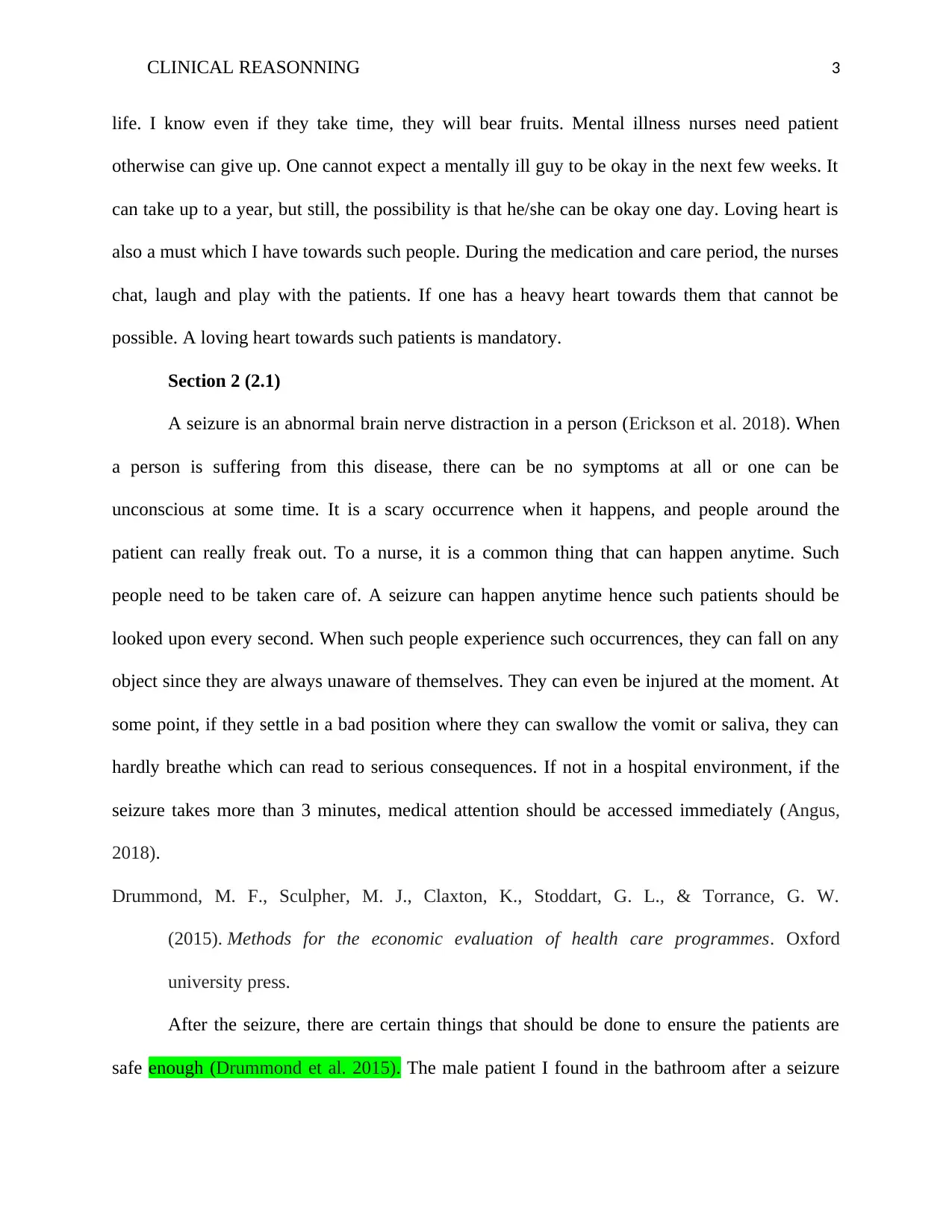
CLINICAL REASONNING 3
life. I know even if they take time, they will bear fruits. Mental illness nurses need patient
otherwise can give up. One cannot expect a mentally ill guy to be okay in the next few weeks. It
can take up to a year, but still, the possibility is that he/she can be okay one day. Loving heart is
also a must which I have towards such people. During the medication and care period, the nurses
chat, laugh and play with the patients. If one has a heavy heart towards them that cannot be
possible. A loving heart towards such patients is mandatory.
Section 2 (2.1)
A seizure is an abnormal brain nerve distraction in a person (Erickson et al. 2018). When
a person is suffering from this disease, there can be no symptoms at all or one can be
unconscious at some time. It is a scary occurrence when it happens, and people around the
patient can really freak out. To a nurse, it is a common thing that can happen anytime. Such
people need to be taken care of. A seizure can happen anytime hence such patients should be
looked upon every second. When such people experience such occurrences, they can fall on any
object since they are always unaware of themselves. They can even be injured at the moment. At
some point, if they settle in a bad position where they can swallow the vomit or saliva, they can
hardly breathe which can read to serious consequences. If not in a hospital environment, if the
seizure takes more than 3 minutes, medical attention should be accessed immediately (Angus,
2018).
Drummond, M. F., Sculpher, M. J., Claxton, K., Stoddart, G. L., & Torrance, G. W.
(2015). Methods for the economic evaluation of health care programmes. Oxford
university press.
After the seizure, there are certain things that should be done to ensure the patients are
safe enough (Drummond et al. 2015). The male patient I found in the bathroom after a seizure
life. I know even if they take time, they will bear fruits. Mental illness nurses need patient
otherwise can give up. One cannot expect a mentally ill guy to be okay in the next few weeks. It
can take up to a year, but still, the possibility is that he/she can be okay one day. Loving heart is
also a must which I have towards such people. During the medication and care period, the nurses
chat, laugh and play with the patients. If one has a heavy heart towards them that cannot be
possible. A loving heart towards such patients is mandatory.
Section 2 (2.1)
A seizure is an abnormal brain nerve distraction in a person (Erickson et al. 2018). When
a person is suffering from this disease, there can be no symptoms at all or one can be
unconscious at some time. It is a scary occurrence when it happens, and people around the
patient can really freak out. To a nurse, it is a common thing that can happen anytime. Such
people need to be taken care of. A seizure can happen anytime hence such patients should be
looked upon every second. When such people experience such occurrences, they can fall on any
object since they are always unaware of themselves. They can even be injured at the moment. At
some point, if they settle in a bad position where they can swallow the vomit or saliva, they can
hardly breathe which can read to serious consequences. If not in a hospital environment, if the
seizure takes more than 3 minutes, medical attention should be accessed immediately (Angus,
2018).
Drummond, M. F., Sculpher, M. J., Claxton, K., Stoddart, G. L., & Torrance, G. W.
(2015). Methods for the economic evaluation of health care programmes. Oxford
university press.
After the seizure, there are certain things that should be done to ensure the patients are
safe enough (Drummond et al. 2015). The male patient I found in the bathroom after a seizure
⊘ This is a preview!⊘
Do you want full access?
Subscribe today to unlock all pages.

Trusted by 1+ million students worldwide
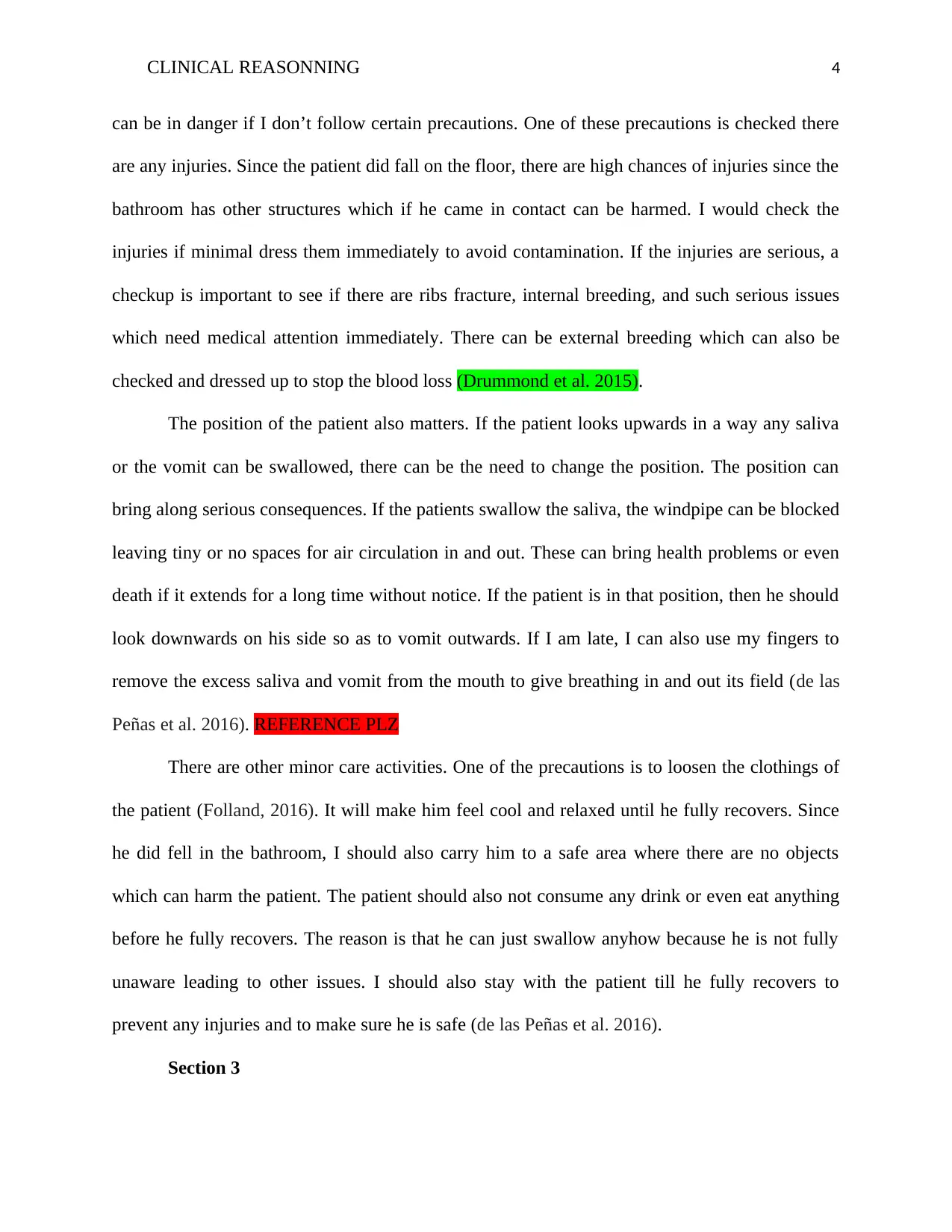
CLINICAL REASONNING 4
can be in danger if I don’t follow certain precautions. One of these precautions is checked there
are any injuries. Since the patient did fall on the floor, there are high chances of injuries since the
bathroom has other structures which if he came in contact can be harmed. I would check the
injuries if minimal dress them immediately to avoid contamination. If the injuries are serious, a
checkup is important to see if there are ribs fracture, internal breeding, and such serious issues
which need medical attention immediately. There can be external breeding which can also be
checked and dressed up to stop the blood loss (Drummond et al. 2015).
The position of the patient also matters. If the patient looks upwards in a way any saliva
or the vomit can be swallowed, there can be the need to change the position. The position can
bring along serious consequences. If the patients swallow the saliva, the windpipe can be blocked
leaving tiny or no spaces for air circulation in and out. These can bring health problems or even
death if it extends for a long time without notice. If the patient is in that position, then he should
look downwards on his side so as to vomit outwards. If I am late, I can also use my fingers to
remove the excess saliva and vomit from the mouth to give breathing in and out its field (de las
Peñas et al. 2016). REFERENCE PLZ
There are other minor care activities. One of the precautions is to loosen the clothings of
the patient (Folland, 2016). It will make him feel cool and relaxed until he fully recovers. Since
he did fell in the bathroom, I should also carry him to a safe area where there are no objects
which can harm the patient. The patient should also not consume any drink or even eat anything
before he fully recovers. The reason is that he can just swallow anyhow because he is not fully
unaware leading to other issues. I should also stay with the patient till he fully recovers to
prevent any injuries and to make sure he is safe (de las Peñas et al. 2016).
Section 3
can be in danger if I don’t follow certain precautions. One of these precautions is checked there
are any injuries. Since the patient did fall on the floor, there are high chances of injuries since the
bathroom has other structures which if he came in contact can be harmed. I would check the
injuries if minimal dress them immediately to avoid contamination. If the injuries are serious, a
checkup is important to see if there are ribs fracture, internal breeding, and such serious issues
which need medical attention immediately. There can be external breeding which can also be
checked and dressed up to stop the blood loss (Drummond et al. 2015).
The position of the patient also matters. If the patient looks upwards in a way any saliva
or the vomit can be swallowed, there can be the need to change the position. The position can
bring along serious consequences. If the patients swallow the saliva, the windpipe can be blocked
leaving tiny or no spaces for air circulation in and out. These can bring health problems or even
death if it extends for a long time without notice. If the patient is in that position, then he should
look downwards on his side so as to vomit outwards. If I am late, I can also use my fingers to
remove the excess saliva and vomit from the mouth to give breathing in and out its field (de las
Peñas et al. 2016). REFERENCE PLZ
There are other minor care activities. One of the precautions is to loosen the clothings of
the patient (Folland, 2016). It will make him feel cool and relaxed until he fully recovers. Since
he did fell in the bathroom, I should also carry him to a safe area where there are no objects
which can harm the patient. The patient should also not consume any drink or even eat anything
before he fully recovers. The reason is that he can just swallow anyhow because he is not fully
unaware leading to other issues. I should also stay with the patient till he fully recovers to
prevent any injuries and to make sure he is safe (de las Peñas et al. 2016).
Section 3
Paraphrase This Document
Need a fresh take? Get an instant paraphrase of this document with our AI Paraphraser
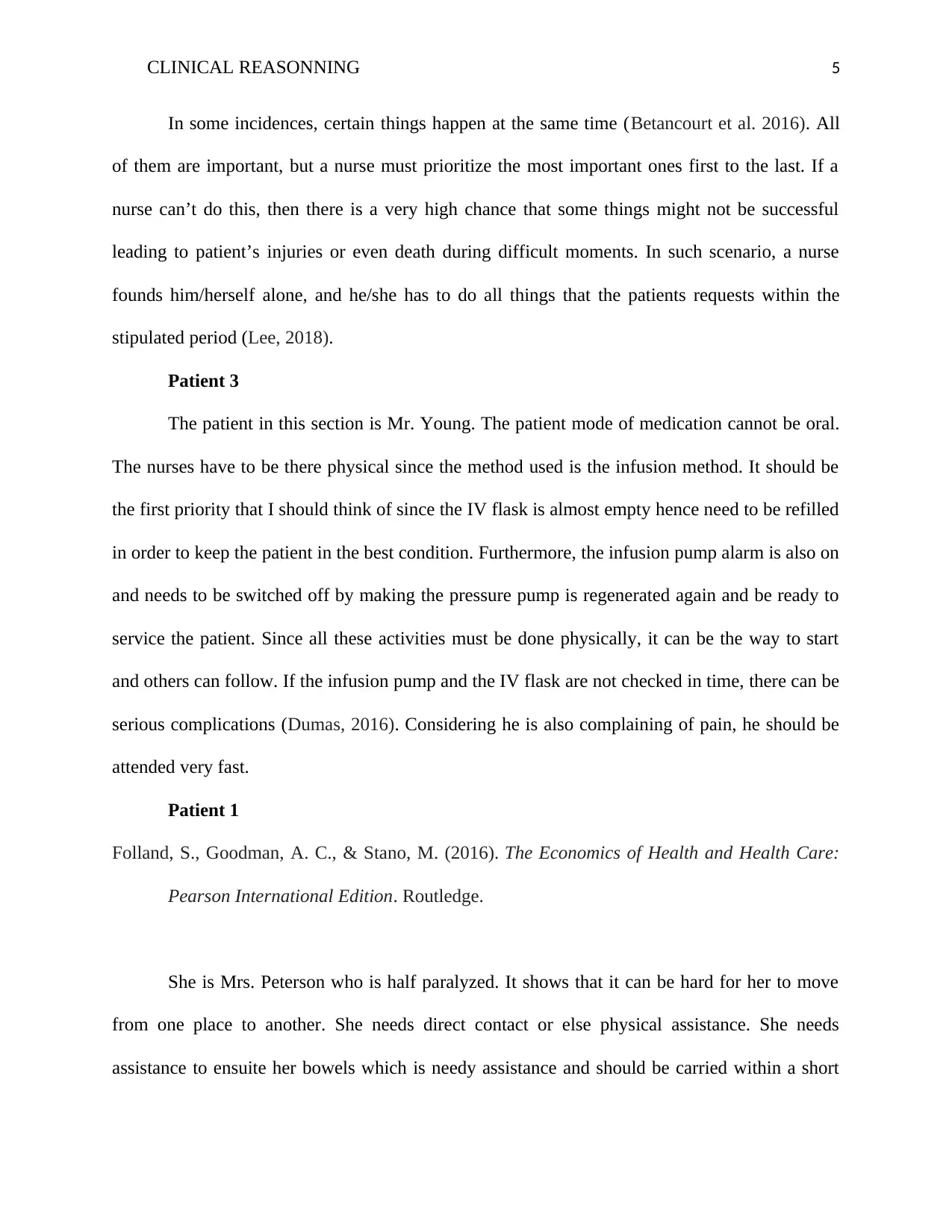
CLINICAL REASONNING 5
In some incidences, certain things happen at the same time (Betancourt et al. 2016). All
of them are important, but a nurse must prioritize the most important ones first to the last. If a
nurse can’t do this, then there is a very high chance that some things might not be successful
leading to patient’s injuries or even death during difficult moments. In such scenario, a nurse
founds him/herself alone, and he/she has to do all things that the patients requests within the
stipulated period (Lee, 2018).
Patient 3
The patient in this section is Mr. Young. The patient mode of medication cannot be oral.
The nurses have to be there physical since the method used is the infusion method. It should be
the first priority that I should think of since the IV flask is almost empty hence need to be refilled
in order to keep the patient in the best condition. Furthermore, the infusion pump alarm is also on
and needs to be switched off by making the pressure pump is regenerated again and be ready to
service the patient. Since all these activities must be done physically, it can be the way to start
and others can follow. If the infusion pump and the IV flask are not checked in time, there can be
serious complications (Dumas, 2016). Considering he is also complaining of pain, he should be
attended very fast.
Patient 1
Folland, S., Goodman, A. C., & Stano, M. (2016). The Economics of Health and Health Care:
Pearson International Edition. Routledge.
She is Mrs. Peterson who is half paralyzed. It shows that it can be hard for her to move
from one place to another. She needs direct contact or else physical assistance. She needs
assistance to ensuite her bowels which is needy assistance and should be carried within a short
In some incidences, certain things happen at the same time (Betancourt et al. 2016). All
of them are important, but a nurse must prioritize the most important ones first to the last. If a
nurse can’t do this, then there is a very high chance that some things might not be successful
leading to patient’s injuries or even death during difficult moments. In such scenario, a nurse
founds him/herself alone, and he/she has to do all things that the patients requests within the
stipulated period (Lee, 2018).
Patient 3
The patient in this section is Mr. Young. The patient mode of medication cannot be oral.
The nurses have to be there physical since the method used is the infusion method. It should be
the first priority that I should think of since the IV flask is almost empty hence need to be refilled
in order to keep the patient in the best condition. Furthermore, the infusion pump alarm is also on
and needs to be switched off by making the pressure pump is regenerated again and be ready to
service the patient. Since all these activities must be done physically, it can be the way to start
and others can follow. If the infusion pump and the IV flask are not checked in time, there can be
serious complications (Dumas, 2016). Considering he is also complaining of pain, he should be
attended very fast.
Patient 1
Folland, S., Goodman, A. C., & Stano, M. (2016). The Economics of Health and Health Care:
Pearson International Edition. Routledge.
She is Mrs. Peterson who is half paralyzed. It shows that it can be hard for her to move
from one place to another. She needs direct contact or else physical assistance. She needs
assistance to ensuite her bowels which is needy assistance and should be carried within a short
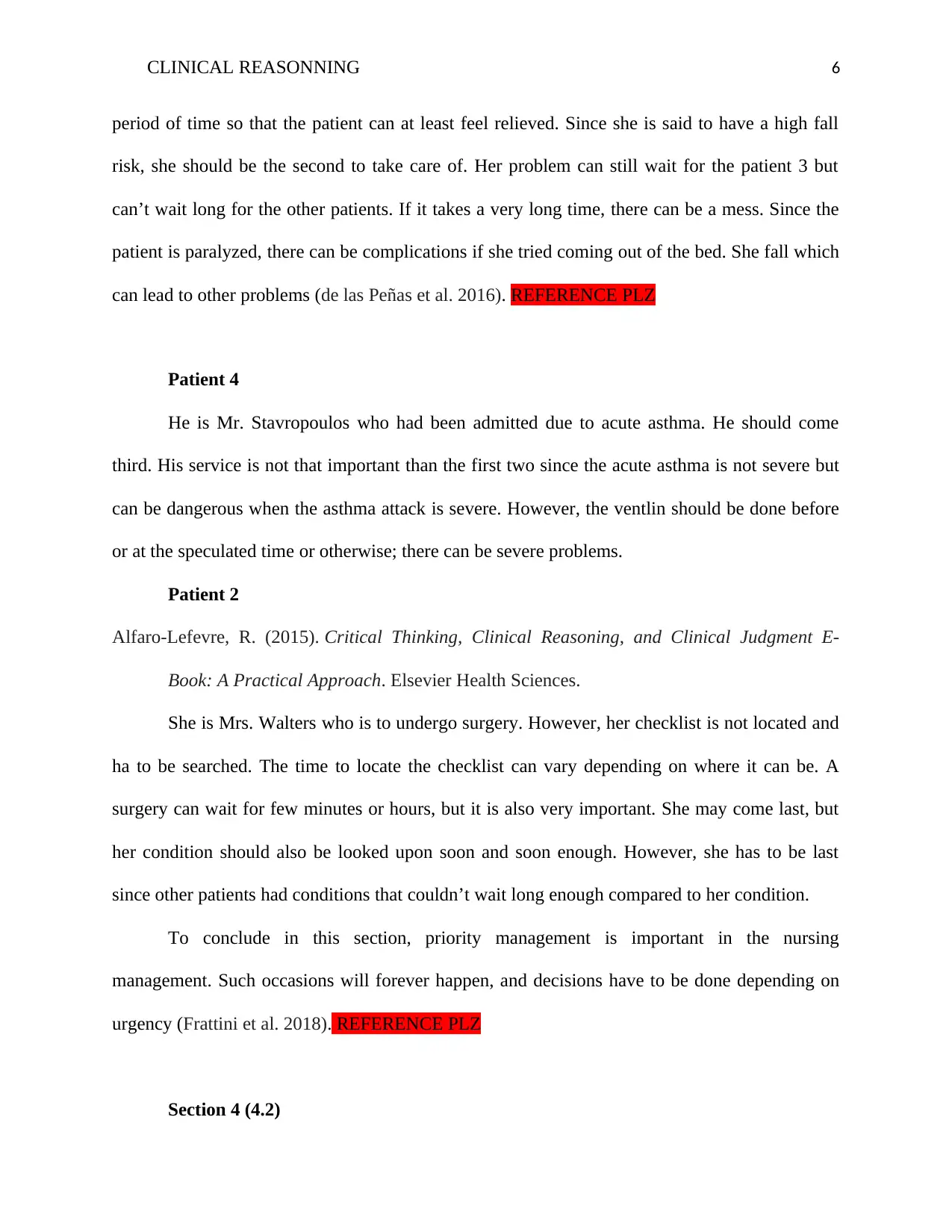
CLINICAL REASONNING 6
period of time so that the patient can at least feel relieved. Since she is said to have a high fall
risk, she should be the second to take care of. Her problem can still wait for the patient 3 but
can’t wait long for the other patients. If it takes a very long time, there can be a mess. Since the
patient is paralyzed, there can be complications if she tried coming out of the bed. She fall which
can lead to other problems (de las Peñas et al. 2016). REFERENCE PLZ
Patient 4
He is Mr. Stavropoulos who had been admitted due to acute asthma. He should come
third. His service is not that important than the first two since the acute asthma is not severe but
can be dangerous when the asthma attack is severe. However, the ventlin should be done before
or at the speculated time or otherwise; there can be severe problems.
Patient 2
Alfaro-Lefevre, R. (2015). Critical Thinking, Clinical Reasoning, and Clinical Judgment E-
Book: A Practical Approach. Elsevier Health Sciences.
She is Mrs. Walters who is to undergo surgery. However, her checklist is not located and
ha to be searched. The time to locate the checklist can vary depending on where it can be. A
surgery can wait for few minutes or hours, but it is also very important. She may come last, but
her condition should also be looked upon soon and soon enough. However, she has to be last
since other patients had conditions that couldn’t wait long enough compared to her condition.
To conclude in this section, priority management is important in the nursing
management. Such occasions will forever happen, and decisions have to be done depending on
urgency (Frattini et al. 2018). REFERENCE PLZ
Section 4 (4.2)
period of time so that the patient can at least feel relieved. Since she is said to have a high fall
risk, she should be the second to take care of. Her problem can still wait for the patient 3 but
can’t wait long for the other patients. If it takes a very long time, there can be a mess. Since the
patient is paralyzed, there can be complications if she tried coming out of the bed. She fall which
can lead to other problems (de las Peñas et al. 2016). REFERENCE PLZ
Patient 4
He is Mr. Stavropoulos who had been admitted due to acute asthma. He should come
third. His service is not that important than the first two since the acute asthma is not severe but
can be dangerous when the asthma attack is severe. However, the ventlin should be done before
or at the speculated time or otherwise; there can be severe problems.
Patient 2
Alfaro-Lefevre, R. (2015). Critical Thinking, Clinical Reasoning, and Clinical Judgment E-
Book: A Practical Approach. Elsevier Health Sciences.
She is Mrs. Walters who is to undergo surgery. However, her checklist is not located and
ha to be searched. The time to locate the checklist can vary depending on where it can be. A
surgery can wait for few minutes or hours, but it is also very important. She may come last, but
her condition should also be looked upon soon and soon enough. However, she has to be last
since other patients had conditions that couldn’t wait long enough compared to her condition.
To conclude in this section, priority management is important in the nursing
management. Such occasions will forever happen, and decisions have to be done depending on
urgency (Frattini et al. 2018). REFERENCE PLZ
Section 4 (4.2)
⊘ This is a preview!⊘
Do you want full access?
Subscribe today to unlock all pages.

Trusted by 1+ million students worldwide
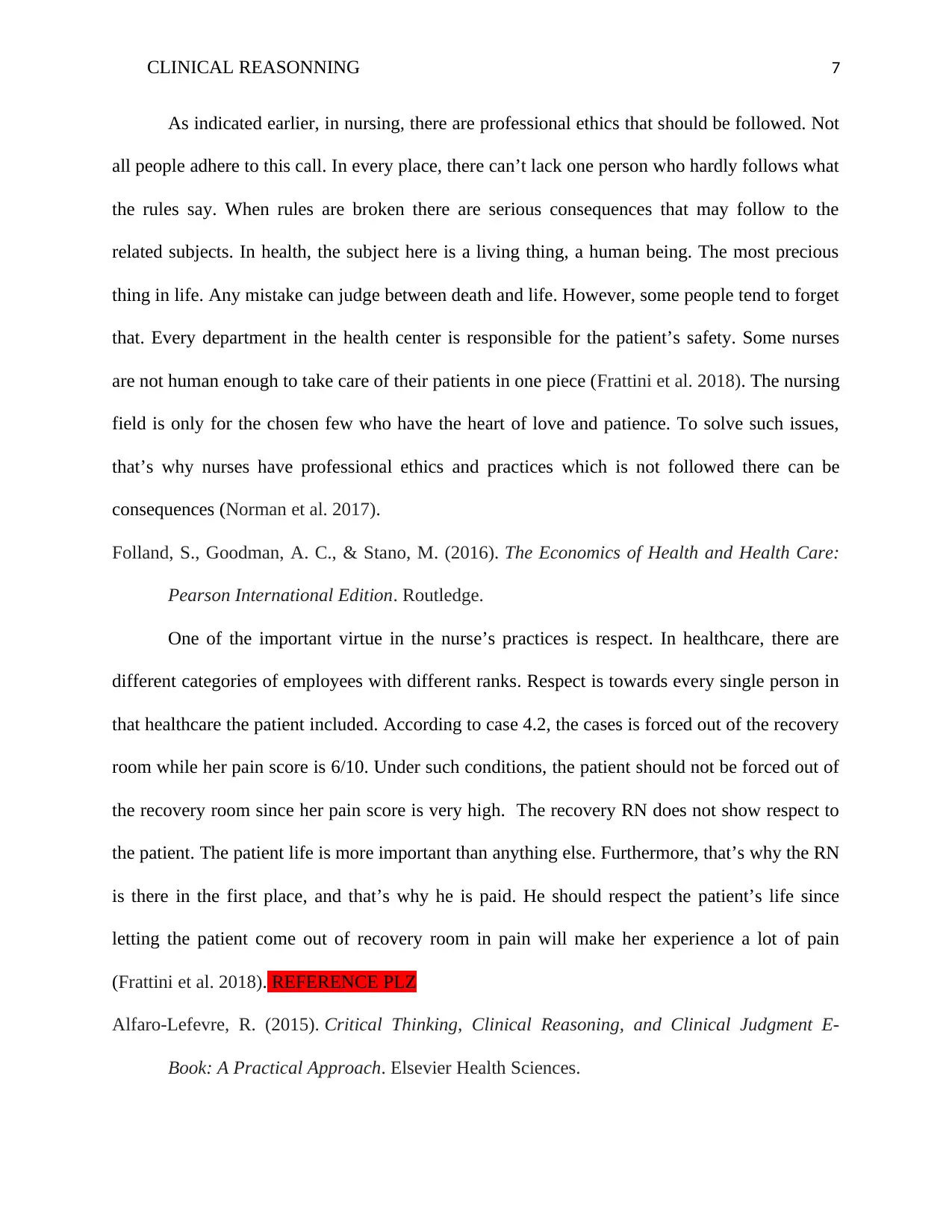
CLINICAL REASONNING 7
As indicated earlier, in nursing, there are professional ethics that should be followed. Not
all people adhere to this call. In every place, there can’t lack one person who hardly follows what
the rules say. When rules are broken there are serious consequences that may follow to the
related subjects. In health, the subject here is a living thing, a human being. The most precious
thing in life. Any mistake can judge between death and life. However, some people tend to forget
that. Every department in the health center is responsible for the patient’s safety. Some nurses
are not human enough to take care of their patients in one piece (Frattini et al. 2018). The nursing
field is only for the chosen few who have the heart of love and patience. To solve such issues,
that’s why nurses have professional ethics and practices which is not followed there can be
consequences (Norman et al. 2017).
Folland, S., Goodman, A. C., & Stano, M. (2016). The Economics of Health and Health Care:
Pearson International Edition. Routledge.
One of the important virtue in the nurse’s practices is respect. In healthcare, there are
different categories of employees with different ranks. Respect is towards every single person in
that healthcare the patient included. According to case 4.2, the cases is forced out of the recovery
room while her pain score is 6/10. Under such conditions, the patient should not be forced out of
the recovery room since her pain score is very high. The recovery RN does not show respect to
the patient. The patient life is more important than anything else. Furthermore, that’s why the RN
is there in the first place, and that’s why he is paid. He should respect the patient’s life since
letting the patient come out of recovery room in pain will make her experience a lot of pain
(Frattini et al. 2018). REFERENCE PLZ
Alfaro-Lefevre, R. (2015). Critical Thinking, Clinical Reasoning, and Clinical Judgment E-
Book: A Practical Approach. Elsevier Health Sciences.
As indicated earlier, in nursing, there are professional ethics that should be followed. Not
all people adhere to this call. In every place, there can’t lack one person who hardly follows what
the rules say. When rules are broken there are serious consequences that may follow to the
related subjects. In health, the subject here is a living thing, a human being. The most precious
thing in life. Any mistake can judge between death and life. However, some people tend to forget
that. Every department in the health center is responsible for the patient’s safety. Some nurses
are not human enough to take care of their patients in one piece (Frattini et al. 2018). The nursing
field is only for the chosen few who have the heart of love and patience. To solve such issues,
that’s why nurses have professional ethics and practices which is not followed there can be
consequences (Norman et al. 2017).
Folland, S., Goodman, A. C., & Stano, M. (2016). The Economics of Health and Health Care:
Pearson International Edition. Routledge.
One of the important virtue in the nurse’s practices is respect. In healthcare, there are
different categories of employees with different ranks. Respect is towards every single person in
that healthcare the patient included. According to case 4.2, the cases is forced out of the recovery
room while her pain score is 6/10. Under such conditions, the patient should not be forced out of
the recovery room since her pain score is very high. The recovery RN does not show respect to
the patient. The patient life is more important than anything else. Furthermore, that’s why the RN
is there in the first place, and that’s why he is paid. He should respect the patient’s life since
letting the patient come out of recovery room in pain will make her experience a lot of pain
(Frattini et al. 2018). REFERENCE PLZ
Alfaro-Lefevre, R. (2015). Critical Thinking, Clinical Reasoning, and Clinical Judgment E-
Book: A Practical Approach. Elsevier Health Sciences.
Paraphrase This Document
Need a fresh take? Get an instant paraphrase of this document with our AI Paraphraser
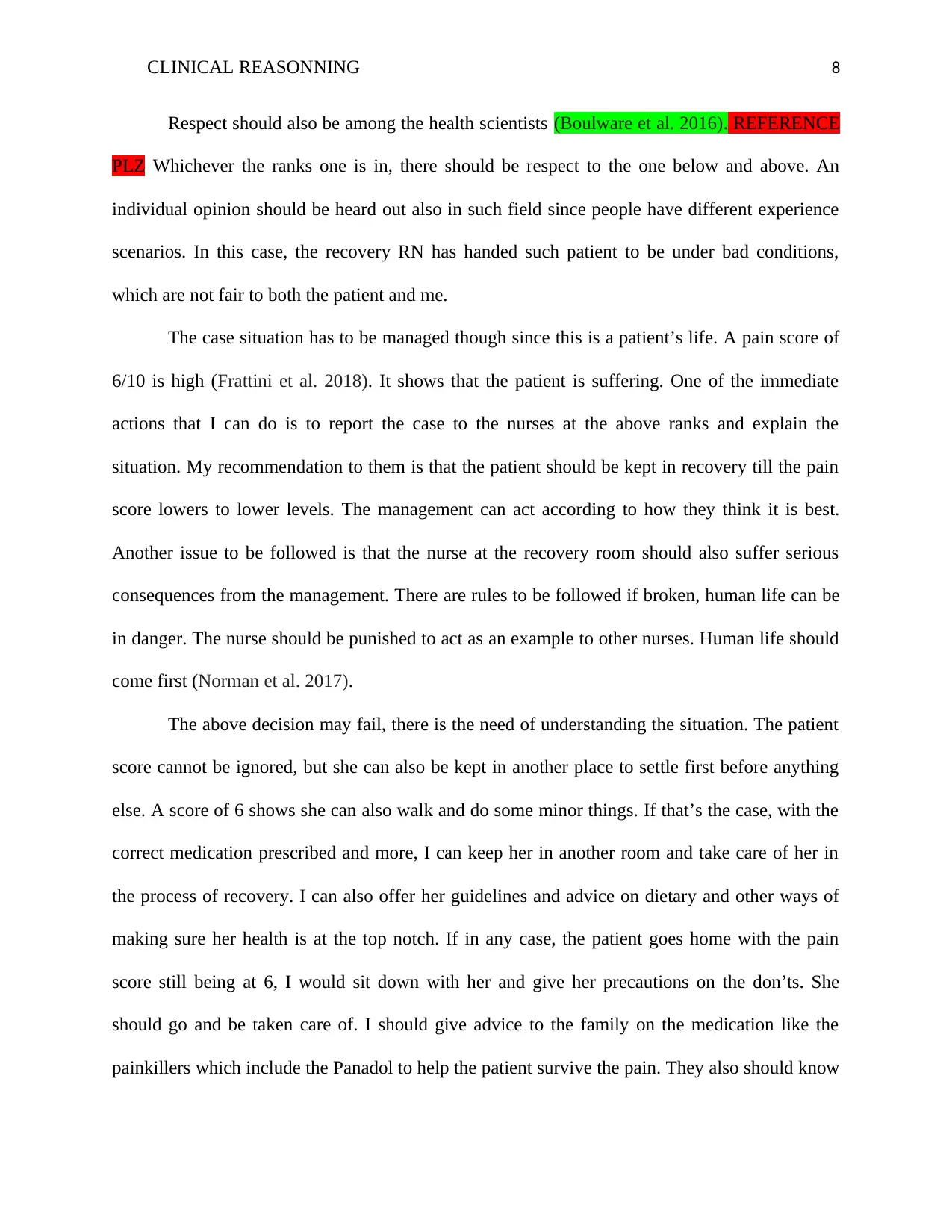
CLINICAL REASONNING 8
Respect should also be among the health scientists (Boulware et al. 2016). REFERENCE
PLZ Whichever the ranks one is in, there should be respect to the one below and above. An
individual opinion should be heard out also in such field since people have different experience
scenarios. In this case, the recovery RN has handed such patient to be under bad conditions,
which are not fair to both the patient and me.
The case situation has to be managed though since this is a patient’s life. A pain score of
6/10 is high (Frattini et al. 2018). It shows that the patient is suffering. One of the immediate
actions that I can do is to report the case to the nurses at the above ranks and explain the
situation. My recommendation to them is that the patient should be kept in recovery till the pain
score lowers to lower levels. The management can act according to how they think it is best.
Another issue to be followed is that the nurse at the recovery room should also suffer serious
consequences from the management. There are rules to be followed if broken, human life can be
in danger. The nurse should be punished to act as an example to other nurses. Human life should
come first (Norman et al. 2017).
The above decision may fail, there is the need of understanding the situation. The patient
score cannot be ignored, but she can also be kept in another place to settle first before anything
else. A score of 6 shows she can also walk and do some minor things. If that’s the case, with the
correct medication prescribed and more, I can keep her in another room and take care of her in
the process of recovery. I can also offer her guidelines and advice on dietary and other ways of
making sure her health is at the top notch. If in any case, the patient goes home with the pain
score still being at 6, I would sit down with her and give her precautions on the don’ts. She
should go and be taken care of. I should give advice to the family on the medication like the
painkillers which include the Panadol to help the patient survive the pain. They also should know
Respect should also be among the health scientists (Boulware et al. 2016). REFERENCE
PLZ Whichever the ranks one is in, there should be respect to the one below and above. An
individual opinion should be heard out also in such field since people have different experience
scenarios. In this case, the recovery RN has handed such patient to be under bad conditions,
which are not fair to both the patient and me.
The case situation has to be managed though since this is a patient’s life. A pain score of
6/10 is high (Frattini et al. 2018). It shows that the patient is suffering. One of the immediate
actions that I can do is to report the case to the nurses at the above ranks and explain the
situation. My recommendation to them is that the patient should be kept in recovery till the pain
score lowers to lower levels. The management can act according to how they think it is best.
Another issue to be followed is that the nurse at the recovery room should also suffer serious
consequences from the management. There are rules to be followed if broken, human life can be
in danger. The nurse should be punished to act as an example to other nurses. Human life should
come first (Norman et al. 2017).
The above decision may fail, there is the need of understanding the situation. The patient
score cannot be ignored, but she can also be kept in another place to settle first before anything
else. A score of 6 shows she can also walk and do some minor things. If that’s the case, with the
correct medication prescribed and more, I can keep her in another room and take care of her in
the process of recovery. I can also offer her guidelines and advice on dietary and other ways of
making sure her health is at the top notch. If in any case, the patient goes home with the pain
score still being at 6, I would sit down with her and give her precautions on the don’ts. She
should go and be taken care of. I should give advice to the family on the medication like the
painkillers which include the Panadol to help the patient survive the pain. They also should know
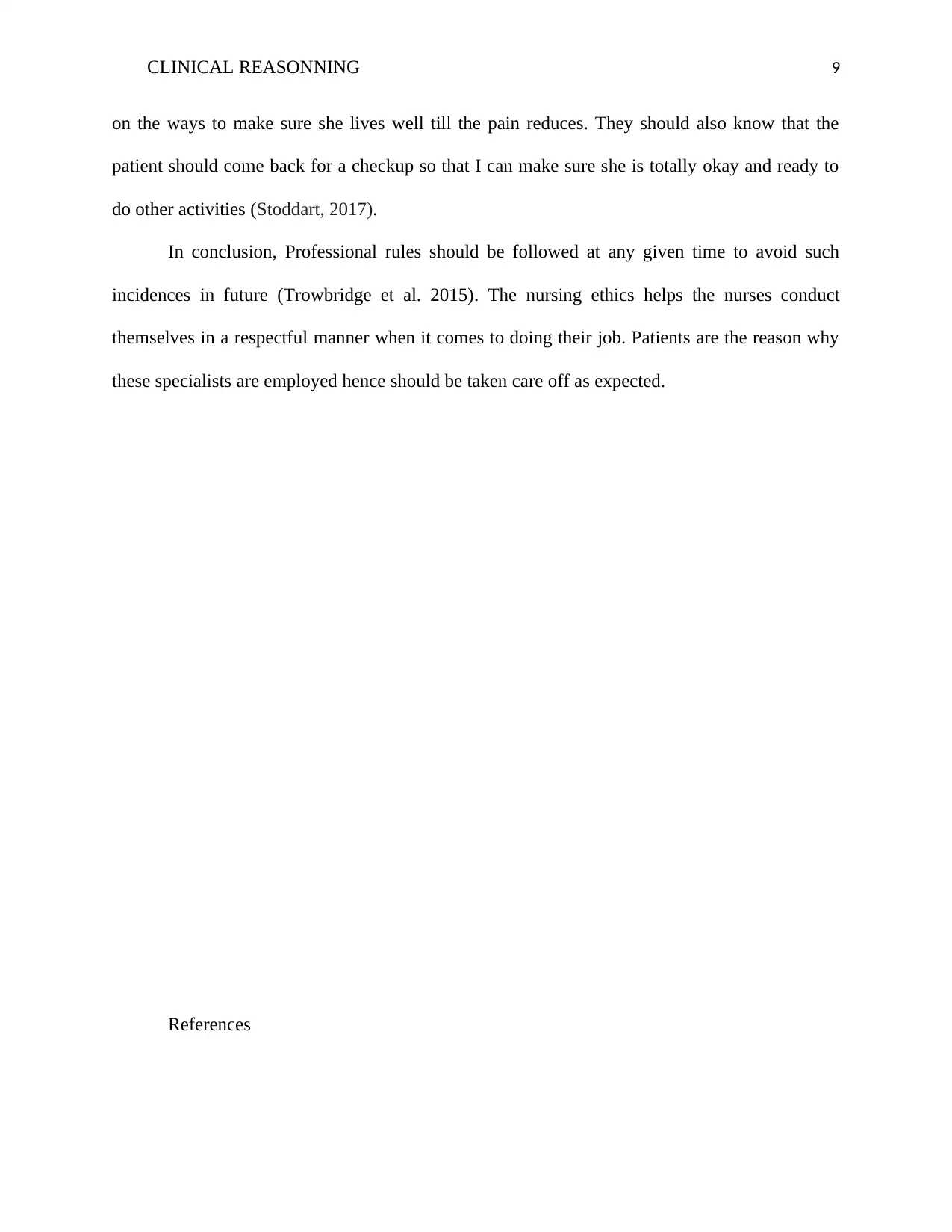
CLINICAL REASONNING 9
on the ways to make sure she lives well till the pain reduces. They should also know that the
patient should come back for a checkup so that I can make sure she is totally okay and ready to
do other activities (Stoddart, 2017).
In conclusion, Professional rules should be followed at any given time to avoid such
incidences in future (Trowbridge et al. 2015). The nursing ethics helps the nurses conduct
themselves in a respectful manner when it comes to doing their job. Patients are the reason why
these specialists are employed hence should be taken care off as expected.
References
on the ways to make sure she lives well till the pain reduces. They should also know that the
patient should come back for a checkup so that I can make sure she is totally okay and ready to
do other activities (Stoddart, 2017).
In conclusion, Professional rules should be followed at any given time to avoid such
incidences in future (Trowbridge et al. 2015). The nursing ethics helps the nurses conduct
themselves in a respectful manner when it comes to doing their job. Patients are the reason why
these specialists are employed hence should be taken care off as expected.
References
⊘ This is a preview!⊘
Do you want full access?
Subscribe today to unlock all pages.

Trusted by 1+ million students worldwide
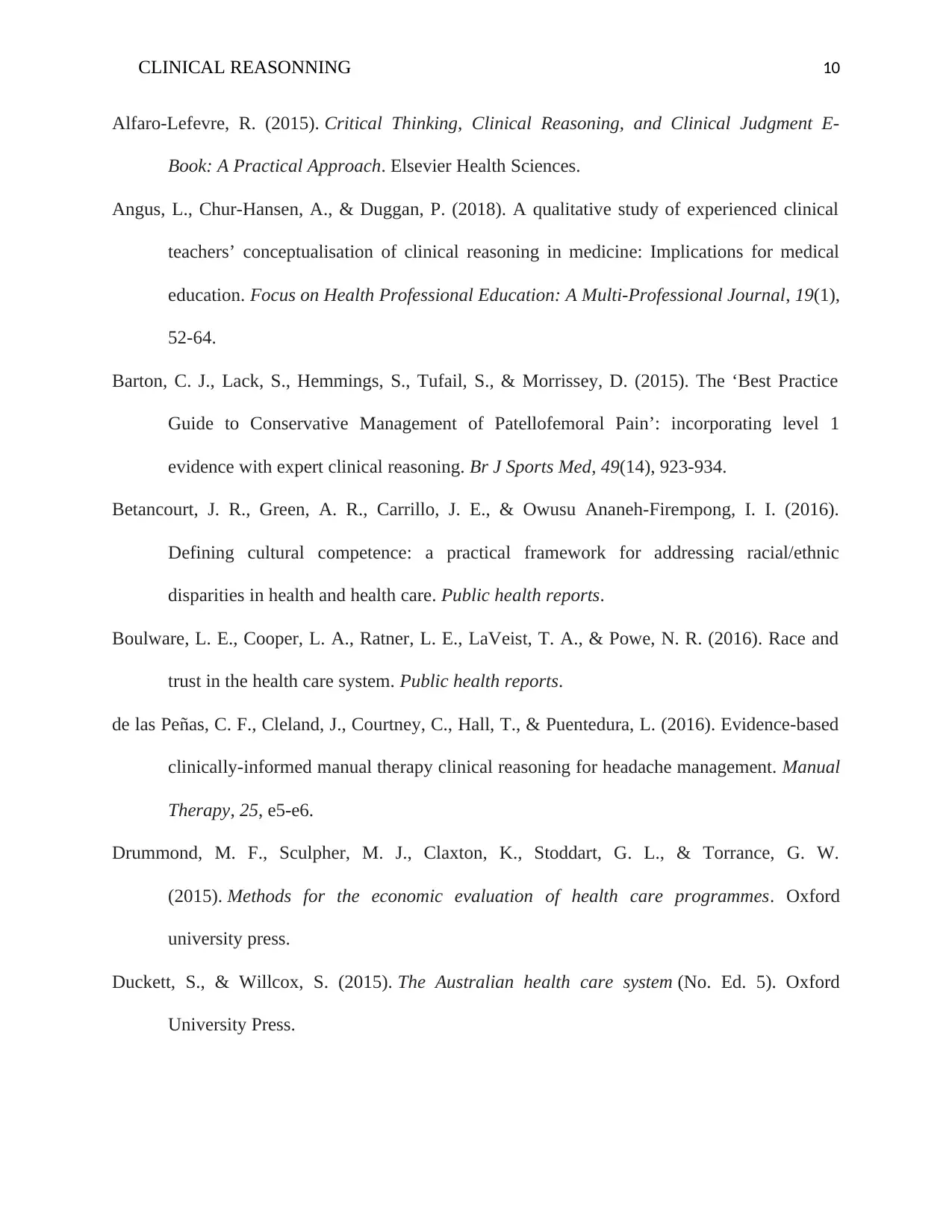
CLINICAL REASONNING 10
Alfaro-Lefevre, R. (2015). Critical Thinking, Clinical Reasoning, and Clinical Judgment E-
Book: A Practical Approach. Elsevier Health Sciences.
Angus, L., Chur-Hansen, A., & Duggan, P. (2018). A qualitative study of experienced clinical
teachers’ conceptualisation of clinical reasoning in medicine: Implications for medical
education. Focus on Health Professional Education: A Multi-Professional Journal, 19(1),
52-64.
Barton, C. J., Lack, S., Hemmings, S., Tufail, S., & Morrissey, D. (2015). The ‘Best Practice
Guide to Conservative Management of Patellofemoral Pain’: incorporating level 1
evidence with expert clinical reasoning. Br J Sports Med, 49(14), 923-934.
Betancourt, J. R., Green, A. R., Carrillo, J. E., & Owusu Ananeh-Firempong, I. I. (2016).
Defining cultural competence: a practical framework for addressing racial/ethnic
disparities in health and health care. Public health reports.
Boulware, L. E., Cooper, L. A., Ratner, L. E., LaVeist, T. A., & Powe, N. R. (2016). Race and
trust in the health care system. Public health reports.
de las Peñas, C. F., Cleland, J., Courtney, C., Hall, T., & Puentedura, L. (2016). Evidence-based
clinically-informed manual therapy clinical reasoning for headache management. Manual
Therapy, 25, e5-e6.
Drummond, M. F., Sculpher, M. J., Claxton, K., Stoddart, G. L., & Torrance, G. W.
(2015). Methods for the economic evaluation of health care programmes. Oxford
university press.
Duckett, S., & Willcox, S. (2015). The Australian health care system (No. Ed. 5). Oxford
University Press.
Alfaro-Lefevre, R. (2015). Critical Thinking, Clinical Reasoning, and Clinical Judgment E-
Book: A Practical Approach. Elsevier Health Sciences.
Angus, L., Chur-Hansen, A., & Duggan, P. (2018). A qualitative study of experienced clinical
teachers’ conceptualisation of clinical reasoning in medicine: Implications for medical
education. Focus on Health Professional Education: A Multi-Professional Journal, 19(1),
52-64.
Barton, C. J., Lack, S., Hemmings, S., Tufail, S., & Morrissey, D. (2015). The ‘Best Practice
Guide to Conservative Management of Patellofemoral Pain’: incorporating level 1
evidence with expert clinical reasoning. Br J Sports Med, 49(14), 923-934.
Betancourt, J. R., Green, A. R., Carrillo, J. E., & Owusu Ananeh-Firempong, I. I. (2016).
Defining cultural competence: a practical framework for addressing racial/ethnic
disparities in health and health care. Public health reports.
Boulware, L. E., Cooper, L. A., Ratner, L. E., LaVeist, T. A., & Powe, N. R. (2016). Race and
trust in the health care system. Public health reports.
de las Peñas, C. F., Cleland, J., Courtney, C., Hall, T., & Puentedura, L. (2016). Evidence-based
clinically-informed manual therapy clinical reasoning for headache management. Manual
Therapy, 25, e5-e6.
Drummond, M. F., Sculpher, M. J., Claxton, K., Stoddart, G. L., & Torrance, G. W.
(2015). Methods for the economic evaluation of health care programmes. Oxford
university press.
Duckett, S., & Willcox, S. (2015). The Australian health care system (No. Ed. 5). Oxford
University Press.
Paraphrase This Document
Need a fresh take? Get an instant paraphrase of this document with our AI Paraphraser
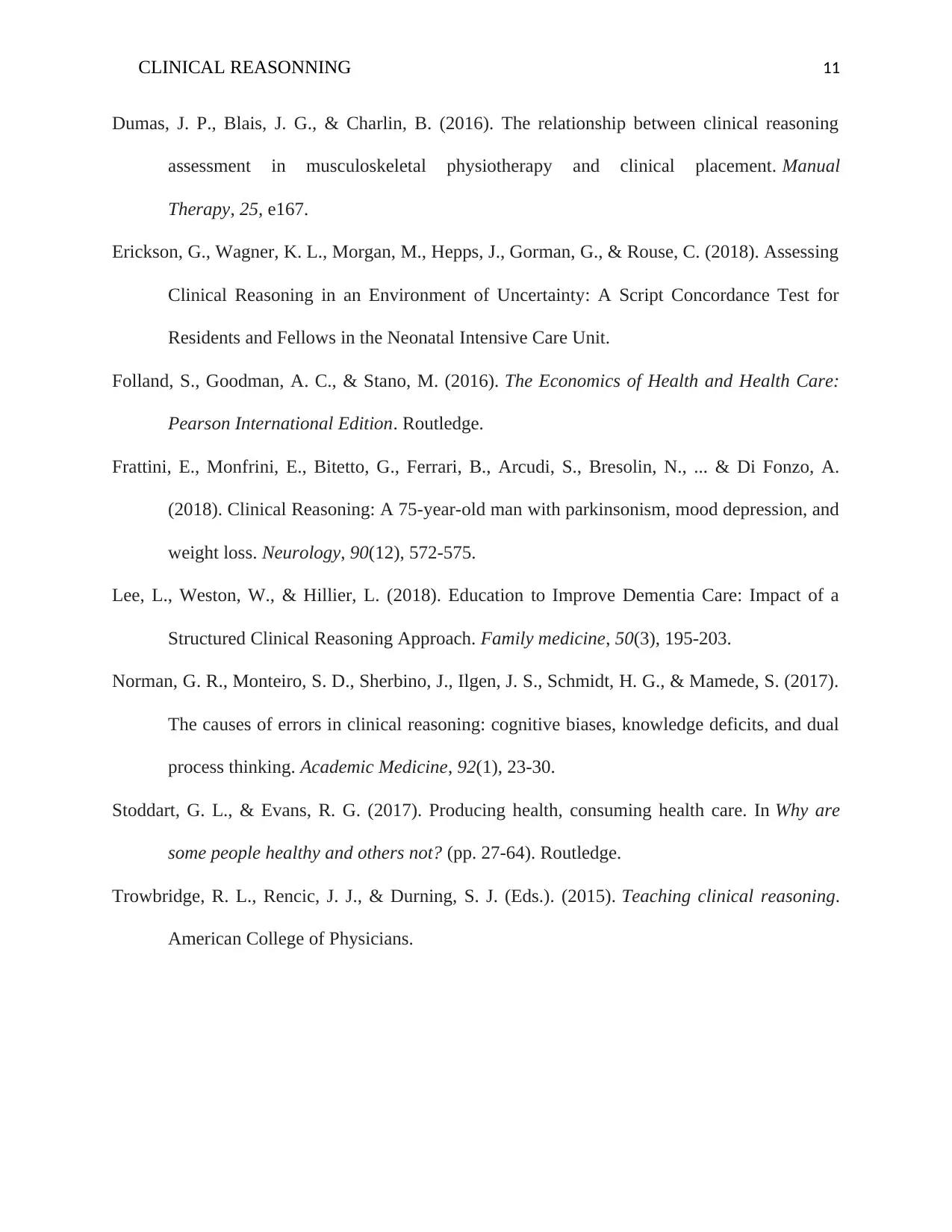
CLINICAL REASONNING 11
Dumas, J. P., Blais, J. G., & Charlin, B. (2016). The relationship between clinical reasoning
assessment in musculoskeletal physiotherapy and clinical placement. Manual
Therapy, 25, e167.
Erickson, G., Wagner, K. L., Morgan, M., Hepps, J., Gorman, G., & Rouse, C. (2018). Assessing
Clinical Reasoning in an Environment of Uncertainty: A Script Concordance Test for
Residents and Fellows in the Neonatal Intensive Care Unit.
Folland, S., Goodman, A. C., & Stano, M. (2016). The Economics of Health and Health Care:
Pearson International Edition. Routledge.
Frattini, E., Monfrini, E., Bitetto, G., Ferrari, B., Arcudi, S., Bresolin, N., ... & Di Fonzo, A.
(2018). Clinical Reasoning: A 75-year-old man with parkinsonism, mood depression, and
weight loss. Neurology, 90(12), 572-575.
Lee, L., Weston, W., & Hillier, L. (2018). Education to Improve Dementia Care: Impact of a
Structured Clinical Reasoning Approach. Family medicine, 50(3), 195-203.
Norman, G. R., Monteiro, S. D., Sherbino, J., Ilgen, J. S., Schmidt, H. G., & Mamede, S. (2017).
The causes of errors in clinical reasoning: cognitive biases, knowledge deficits, and dual
process thinking. Academic Medicine, 92(1), 23-30.
Stoddart, G. L., & Evans, R. G. (2017). Producing health, consuming health care. In Why are
some people healthy and others not? (pp. 27-64). Routledge.
Trowbridge, R. L., Rencic, J. J., & Durning, S. J. (Eds.). (2015). Teaching clinical reasoning.
American College of Physicians.
Dumas, J. P., Blais, J. G., & Charlin, B. (2016). The relationship between clinical reasoning
assessment in musculoskeletal physiotherapy and clinical placement. Manual
Therapy, 25, e167.
Erickson, G., Wagner, K. L., Morgan, M., Hepps, J., Gorman, G., & Rouse, C. (2018). Assessing
Clinical Reasoning in an Environment of Uncertainty: A Script Concordance Test for
Residents and Fellows in the Neonatal Intensive Care Unit.
Folland, S., Goodman, A. C., & Stano, M. (2016). The Economics of Health and Health Care:
Pearson International Edition. Routledge.
Frattini, E., Monfrini, E., Bitetto, G., Ferrari, B., Arcudi, S., Bresolin, N., ... & Di Fonzo, A.
(2018). Clinical Reasoning: A 75-year-old man with parkinsonism, mood depression, and
weight loss. Neurology, 90(12), 572-575.
Lee, L., Weston, W., & Hillier, L. (2018). Education to Improve Dementia Care: Impact of a
Structured Clinical Reasoning Approach. Family medicine, 50(3), 195-203.
Norman, G. R., Monteiro, S. D., Sherbino, J., Ilgen, J. S., Schmidt, H. G., & Mamede, S. (2017).
The causes of errors in clinical reasoning: cognitive biases, knowledge deficits, and dual
process thinking. Academic Medicine, 92(1), 23-30.
Stoddart, G. L., & Evans, R. G. (2017). Producing health, consuming health care. In Why are
some people healthy and others not? (pp. 27-64). Routledge.
Trowbridge, R. L., Rencic, J. J., & Durning, S. J. (Eds.). (2015). Teaching clinical reasoning.
American College of Physicians.
1 out of 11
Related Documents
Your All-in-One AI-Powered Toolkit for Academic Success.
+13062052269
info@desklib.com
Available 24*7 on WhatsApp / Email
![[object Object]](/_next/static/media/star-bottom.7253800d.svg)
Unlock your academic potential
Copyright © 2020–2025 A2Z Services. All Rights Reserved. Developed and managed by ZUCOL.





